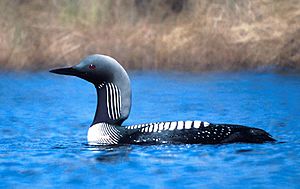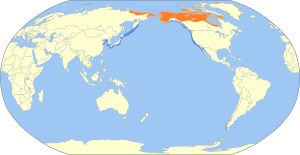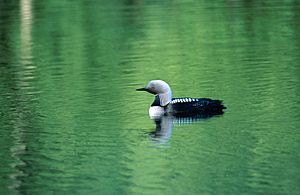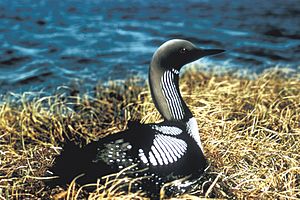Pacific loon facts for kids
Quick facts for kids Pacific loon |
|
|---|---|
 |
|
| Conservation status | |
| Scientific classification | |
| Genus: |
Gavia
|
| Species: |
pacifica
|
 |
|
The Pacific loon or Pacific diver (Gavia pacifica) is a medium-sized bird from the loon family. Loons are also known as divers because they are excellent at swimming and diving underwater.
Contents
About the Pacific Loon's Name
The Pacific loon used to be thought of as the same species as the black-throated loon. But in 1985, scientists decided it was its own separate species.
Its scientific name, Gavia pacifica, has interesting roots. Gavia comes from a Latin word meaning 'sea mew,' used by an old Roman naturalist named Pliny the Elder. The 'pacifica' part is Latin for the Pacific Ocean, meaning 'peaceful.'
What Does the Pacific Loon Look Like?
Adult Pacific loons that are ready to breed look like a smaller, sleeker version of the common loon. They are about 58 to 74 centimeters (23 to 29 inches) long. Their wingspan can be 110 to 128 centimeters (43 to 50 inches). They weigh between 1 and 2.5 kilograms (2.2 to 5.5 pounds).
These loons have a grey head and a black throat. Their underside is white, and their back has a cool black-and-white checkered pattern. The black throat has a shiny purple color. When they are not breeding, their feathers are duller, and their chin and front of the neck are white. Their beak is grey or whitish and shaped like a dagger.
You can tell a Pacific loon apart from the very similar black-throated loon because the Pacific loon does not have a white patch on its side. In winter, you can tell it apart from the red-throated loon because the red-throated loon looks paler. Also, the red-throated loon's head and neck colors are not as different from its throat, and its beak looks like it points upwards.
Like other loons, the Pacific loon's legs are set far back on its body. This helps them swim and hunt for food underwater very well. But it also makes it hard for them to walk on land. Taking off from land is almost impossible for them. They need about 30 to 50 yards (27 to 46 meters) of water to successfully fly into the air. This means they can only breed and feed on larger lakes.
Pacific Loon Calls
Pacific loons make many different sounds, especially in spring and summer. When they are feeding, they might make a sharp, short 'ark' sound.
They also have a loud, eerie 'oo-loo-lee' wail or yodel. This call is similar to the common loon's call and can be heard from miles away. You usually hear this sound during their breeding season. Loons can also make short, harsh 'kok-kok-kok-kok' calls. They also make other small cackles, growls, barks, and clucking noises.
Where Do Pacific Loons Live?
Pacific loons breed on lakes in the tundra, which is a cold, treeless area. In winter, they live in the open ocean or other large bodies of water. They mainly breed in northern Canada and eastern Siberia. They spend their winters along the Pacific coast of North America.
Pacific Loon Movements
Unlike some other loons, Pacific loons might migrate in groups. They spend their winters at sea, mostly along the Pacific coast. They also winter on large lakes in places like China, Japan, North Korea, South Korea, the United States, and Mexico. Sometimes, they have been seen in unusual places like Greenland, Hong Kong, Great Britain, Spain, Finland, and Switzerland.
Pacific Loon Behavior and Life Cycle
Nesting and Reproduction
The Pacific loon builds its nest on the ground close to deep lakes. They make their nests out of piled-up plants.
A female loon usually lays one or two eggs. These eggs are light buff or green with brown spots. They are typically about 76 by 47 millimeters (3 by 1.9 inches) in size. Even though the eggs are laid a few days apart, they usually hatch within a day of each other. The parents sit on the eggs for 23 to 25 days until they hatch.
Protecting Their Home
Pacific loons usually stay with one partner for breeding. They are very good at keeping their nesting lake safe from other loon pairs. Males are better at defending their territory than females. This is likely due to their fighting ability or how well they know the area.
Pacific loons looking for a new lake often visit lakes that are already taken. This, along with how well loons keep their lakes, suggests that there might be many loons in Northern Alaska. The Pacific loon is known to be very aggressive. They have even attacked other birds that come too close to their nesting area.
Both parents work together to protect their young. One parent will guard the nest or young birds while the other aggressively attacks anything they see as a threat. If another animal is on the water, the attacking loon will stretch its head and neck in a threatening way. It will then dive under the animal and try to stab it with its beak when it comes back up. Pacific loons are so aggressive that they have even shown threatening behavior towards airplanes flying overhead in Alaska!
What Do Pacific Loons Eat?
Like all loons, this bird mainly eats fish. They catch their food underwater. They also hunt in groups, often swimming under schools of fish and forcing them up towards the surface. They usually feed closer to the shore than other loons.
Conservation of the Pacific Loon
The number of Pacific loons is currently growing, and they live across a very large area of about 15.7 million square kilometers (6 million square miles). Efforts to protect them focus on watching their populations and keeping track of their numbers and breeding habits.
A recent study in Western Alaskan Arctic found that there are actually 1.5 to 2 times more Pacific loons there than earlier surveys showed. However, there is a possible threat from natural gas and oil companies moving into the National Petroleum Reserve–Alaska (NPRA). This area is one of the main places where Pacific loons breed.
One harmful pollutant for Pacific loons is heavy metals like mercury. This mercury can be found in their habitat because of old mining in the areas where the loons migrate and hunt. High levels of mercury can be very bad for birds that eat fish, like the Pacific loon. Small fish take in mercury, and when a loon eats these fish, the mercury gets into its body. This can cause serious health problems.
Also, studies have shown that when researchers visit loon nests or catch loons, it can affect how many chicks survive. If a parent loon is caught or its nest is visited while it is breeding or incubating eggs, fewer eggs survive. This is probably because Pacific loons nest in remote parts of Western Alaska and are not used to people. This lower survival rate means that more human contact could be very harmful to the loon population.
There have also been reports of Pacific loons eating plastic pollution. This is a growing problem for birds in Canada and around the world. Luckily, because loons dive deep to find food, they are at a lower risk of dying from eating too much plastic. Most of the plastic pollution floats on the surface of the water, not deep down where they hunt.
See also
 In Spanish: Colimbo del Pacífico para niños
In Spanish: Colimbo del Pacífico para niños




